1996 PONTIAC GRAND-AM towing
[x] Cancel search: towingPage 112 of 356

Charging System Indicator Light
The charging system
indicator light will come on
briefly when
you turn on the
ignition, but the engine
is
not running, as a check to
show you it is working.
Then it should go out. .. 1.
. I -1
If it stays on when your engine is running, OF comes on
while you are driving, you may have a problem with the
electrical charging system. It could indicate that you
have a loose generator drive belt or another electrical
problem. Have it checked right away. Driving while this
light
is on could drain your battery.
If you mast drive a short distance with the light on, be
certain to turn off all your accessories, such as themdio
and
air conditioner,
Brake System Warning Light
Your Pontiac’s hydraulic brake system is divided into
two parts. If one part isn’t working, the other part can
still w’ork and
stop you. For good braking, though, you
need both
parts workmg well.
If the warning light comes on, there could be a brake
problem. Have your brake system inspected right away.
BRAKE
This light should come ow
briefly when you turn the
ignitibn key
to RUN. If it
doesn’t come on then, have
it fixed so it will be ready to
warn
you if there’s a
problem,
If the light .comes on while you are driving, pull off the
road and stop carefully. You may notice that the pedal is
harder to push. Or, the pedal may go closer to the floor,
It may take longer to stop. If the light is still on, have the
vehicle towed €or
service, (See “Towing Your Vehicle”
in the Index.)
2-56
ProCarManuals.com
Page 117 of 356

I NOTICE:
If you keep driving your vehicle with this light
on, after a while, your emission controls may nmot
work as well, your fuel economy may not be as
good and your engine may not run as smoothly.
This could lead to costly repairs that may not be
covered by your warranty.
This light should come on, as a check to show you it is
working, when the ignition
is on and the engine is not
running.
If the light doesn’t come on, have it repaired.
This
light will also come on during a malfunction’ in one
of two ways:
0 Light Flashing -- A misfire condition has been
detected.
A misfire increases vehicle emissions and
may damage the emission control system on your
vehicle. Dealer or qualified service center diagnosis
and service is required.
0 Light On Steady -- An emission control system
malfunction has been detected on your vehicle.
Dealer or qualified service center diagnosis and
service may be required.
If the Light Is Flashing
The following may prevent ml
your vehicle:
0 Reduce vehicle speed.
0 Avoid hard accelerations.
0 Avoid steep uphill grades.
e serious damage to
i
If towing a trailer, reduce the amount of cargo being
hauled as-soon as it is possible.
If the light stops flashing and remains on steady, see “If
the Light Is On Steady” following.
If the light continues to flash, when it is safe to do so,
stop the vehicle. Put your vehicle in PARK (P). Turn the
key off, wait at least 10 seconds and restart the engine.
If the light remains on steady, see “If the Light Is On
Steady” following.
If the light is still flashing follow the
previous, steps, and drive the vehicle to
your dealer or
qualified service center for service.
2-61
ProCarManuals.com
Page 177 of 356
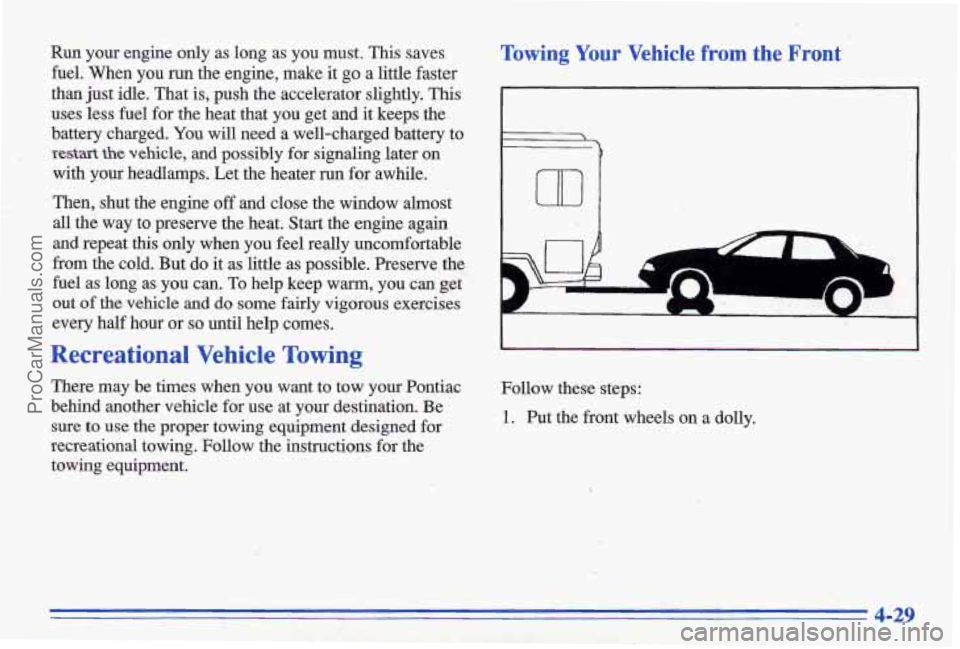
Run your engine only as long as you must. This saves
fuel. When you run the engine, make it go a little faster
than just idle. That is, push the accelerator slightly. This
uses less fuel for the heat that you get and it keeps the
battery charged. You will need a well-charged battery to
rest& the vehicle, and possibly for signaling later on
with your headlamps. Let the heater run for awhile.
Then, shut the engine
off and close the window almost
all the way to preserve the heat. Start the engine again
and repeat this only when you feel really uncomfortable
from the co1d:But do it as little as possible. Preserve the
fuel
as long as you can. To help keep warm, you can get
out of the vehicle and do some fairly vigorous exercises
every half hour or
so until help comes.
Recreational Vehicle Towing
There may be times when you want to tow your Pontiac
behind another vehicle for use at your destination. Be
sure
to use the proper towing equipment designed for
recreational towing. Follow the instructions for the
towing equipment.
Towing Your Vehicle from the Front
Follow these steps:
1. Put the front wheels on a dolly.
i '_ .-
4-29
ProCarManuals.com
Page 178 of 356
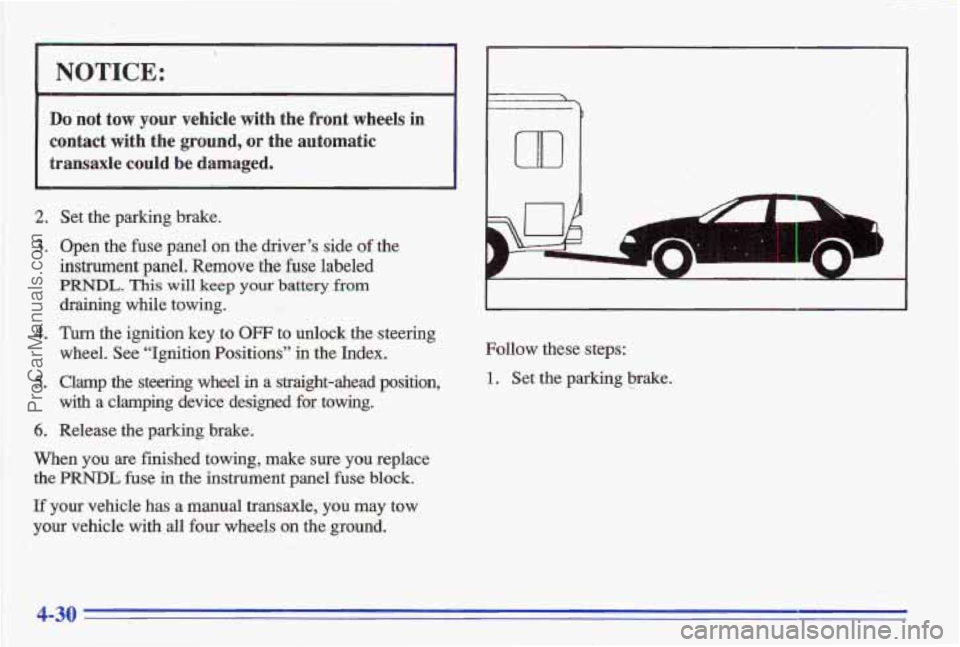
NOTICE:
Do not tow your vehicle with the front wheels in
contact with the
ground, or the automatic
transaxle
could be damaged.
2. Set the parking brake.
3. Open the fuse panel on the driver’s side of the
instrument
panel. Remove the fuse labeled
PRNDL. This will keep your battery from
draining while towing.
wheel. See “Ignition Positions”
in the Index.
with
a clamping device designed for towing.
4. Turn the ignition key to OFF to unlock the steering
5. Clamp the steering wheel in a straight-ahead position,
6. Release the parking brake.
When you are finished towing, make sure you replace
the PRNDL fuse in the instrument panel fuse block.
If your vehicle has a manual transaxle, you may tow
your vehicle with all four wheels on the ground.
m
Follow these steps:
1. Set the parking brake. .
4-30
ProCarManuals.com
Page 179 of 356
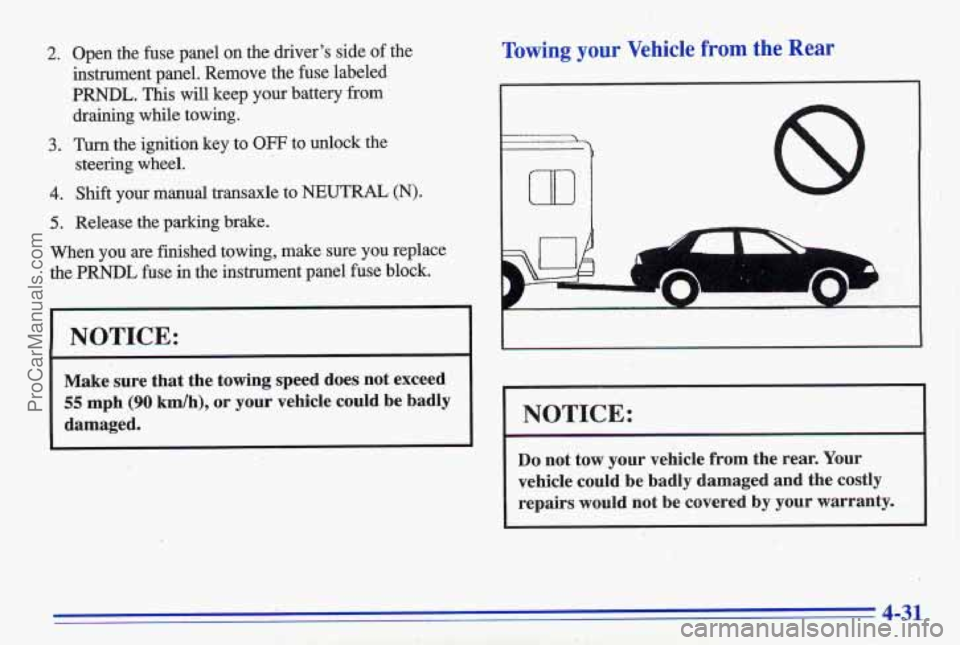
2.
3.
4.
5.
Open the fuse panel on the driver's side of the
instrument panel. Remove the fuse labeled
PRNDL. This will keep your battery from
draining while towing.
Tum the ignition key to OFF to unlock the
steering wheel.
Shift your manual transaxle to
NEUTRAL (N).
Release the parking brake.
When you
are finished towing, make sure you replace
the
PRNDL fuse in the instrument panel fuse block.
NOTICE:
Make sure that the towing speed does not exceed
55 mph (90 kdh), or your vehicle could be badly
damaged.
Towing your Vehicle from the'Rear
'b
8
,NOTICE:
~~ ~
Do not tow your vehicle from the rear. Your
vehicle could be badly damaged and the costly
repairs would not be covered by your warranty.
, .. P 'I
4-31
ProCarManuals.com
Page 182 of 356
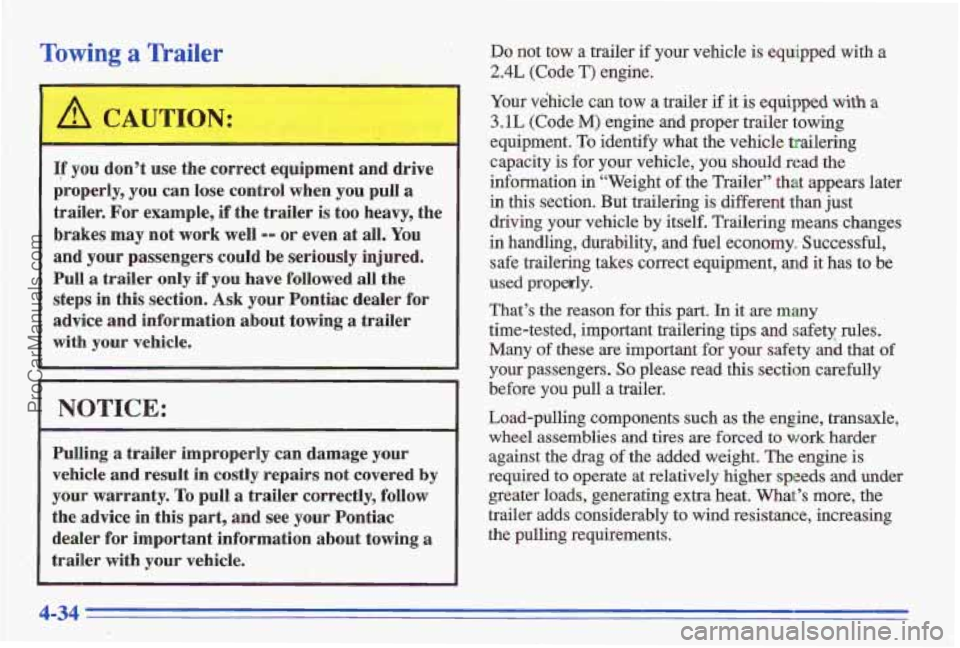
Towing a Trailer
A CAUTION:
If you don't use the correct equipment and drive
properly, you can lose control when
you pull a
trailer. For example, if the trailer is too heavy, the
brakes may not
work well -- or even at all.. You
and your passengers could be seriously injured.
Pull
a trailer only if you have followed all the
steps in this section.
Ask your Pontiac dealer for
advice and information about towing
a trailer
with your vehicle.
Pulling
a traikr improperly can damage your
vehicle and result in costly repairs not covered
by
your warranty. To pull a trailer correctly, follow
the advice in this part, and
see yumr Pontiac
dealer for important information about towing
a
trailer with your vehicle.
Bo not tow a trailer if your vehicle is equipped with a
2.4L (Code T) engine.
Your vehicle can tow a trailer if it is equipped with a
3.1L (Code M) -engine and proper trailer towing
equipment,
To identify what the vehicle trailering
capacity
is for your vehicle, you should read the
information
in "Weight of the Trailer'' that appears later
in this section. But trailering is different than just
driving your vehicle
by itself. Trailering means changes
in handling, durability, md fuel economy. Successful,
safe trailering takes correct equipment, and it has to be
used propetly.
That's the reason for this
part. In it are many
time-tested, important trailering tips and safe% rules.
Many of these are important for your safety and that of
your passengers. So please read this section carefully
before you pull a trailer.
Load-pulling components such as the engine, transaxle,
wheel assemblies and tires are forced to work harder
against
the drag of the added weight. The engine is
required to operate at relatively
higher speeds and under
greater loads, generating extra heat. What,'s more, the
trailer adds considerably to wind resistance, increasing
the gulling requjsernents.
1'
4-34
ProCarManuals.com
Page 183 of 356
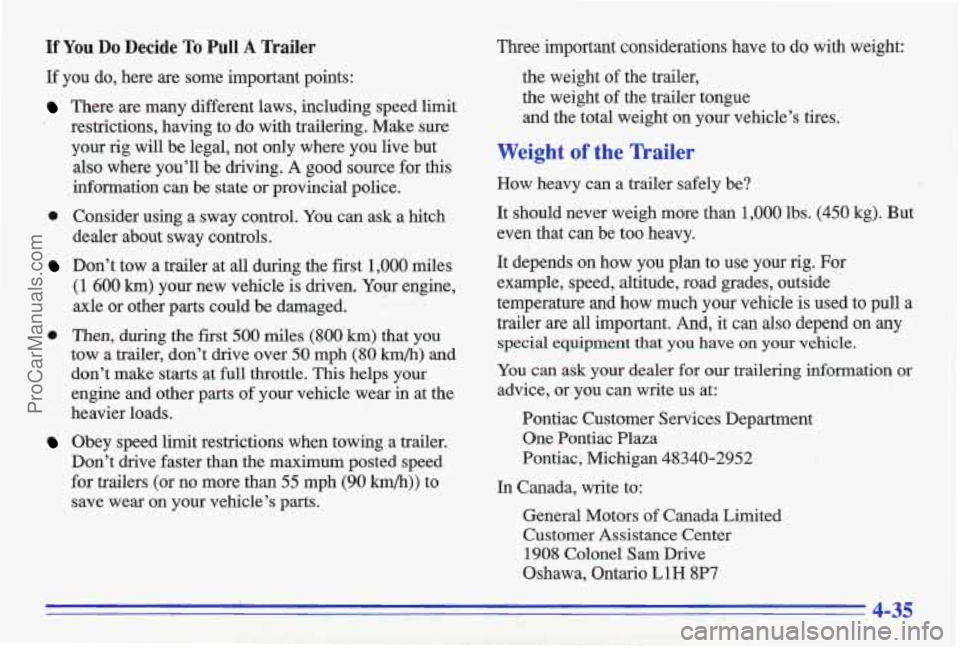
If You Do Decide To Pull A Trailer
If you do, here are some important points:
Three important considerations have to do with weight:
the weight
of the trailer,
There are many different laws, including speed limit
’ restrictions, having to do with trailering. Make sure
your
rig will be legal, not only where you live but Weight of the Trailer
also where you’ll be driving. A good source for this
inforrnation can be state or provincial police. How heavy can a trailer safely be? the weight
of the trailer tongue
and the total weight on your vehicle’s tires.
0 Consider using a sway control. You can ask a hitch It should never weigh more than 1,000 lbs. (450 kg). But
dealer about sway Controls’. even that can be
too heavy.
Don’t tow a trailer at all during the first 1,000 miles It depends on how YOU plan
to use Your fig. For
(1 600 km) your new vehicle is driven. Your engine, exmPle,
speed, altitude, road grades, outside
axle or other parts could
be damaged. temperature and how much your vehicle
is used to pull a
tow a trailer, don’t drive over 50 mph (80 h/h) and
don’t make starts at full throttle. This helps your
You can ask your dealer for our trailering information or
engine and other parts of your vehicle wear in at the advice, Or-You Can write
US at:
heavier loads. Pontiac Customer Services Department
Don’t drive faster than the maximum posted speed Pontiac, Mi\
chigan 48340-2952 trailer are
all important. And,
it can also depend on any 0 Then, during the first 500 miles (800 km) that you
special equipment that you have on your vehicle.
Obey speed limit restrictions when towing a trailer. One Pontia\
c Plaza
for trailers (or no more than 55 mph (90 lun/hj) to
save wear on your vehicle’s parts. In Canada, write to:
General Motors of Canada Limited
Customer Assistance Center
1908 Colonel Sam Drive
Oshawa, Ontario
L1H 8P7
4-35
ProCarManuals.com
Page 186 of 356
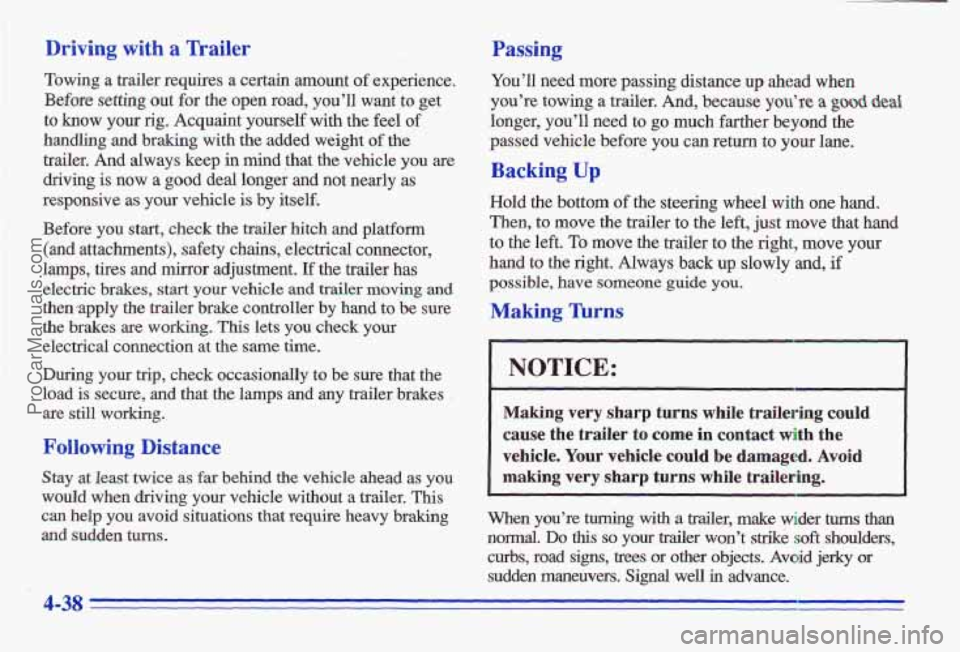
Driving with a Trailer
Towing a trailer requires a certain amount of experience.
Before setting out for the open road, you’ll want’to get
to know your rig. Acquaint yourself with the feel of
handling and braking with the added weight of the
trailer.
And always keep in mind that the vehicle you are
driving is now a good deal longer and not nearly as
responsive as your vehicle is by itselfi.
Before you
start, check the trailer hitch and platform
(and attachments), safety
chains, electrical connector,
lamps, tires and
mirror adjustment, If the trailer has
electric brakes, start your vehicle and trailer moving and
then/apply the trailer brake controller by hand to be sure
the brakes are working. This lets you check your
electrical connection at the
same tirne.
During your trip, check occasionally to be sure that the
load
is secure, and that the lamps and any trailer brakes ,
are still working.
Following Distance
Stay at least twice as far b’ehind the vehicle ahead as you
would when driving your vehicle without a trailer,
This
can help you avoid situations that require heavv braking
and sudden
turns.
Passing
You’ll need more passing distance up ,ahead when
you’re towing a trailer. And, because
you’re a good
longer, you’ll need to go much farther beyond the
passed vehicle before you can return to your lane.
Backing Up
Hold the bottom of the steering wheel with one hand.
Then, to move the trailer to the left, just move that
hand
to the left. To move the trailer to the right, move your
hand to the right. Always back up slowly and, if
possible, have someone guide you.
Making Thrns
I NOTICE:
Making very sharp turns while trailering could
cause th’e trailer to come in contact with the
vehicle. Your vehicle could be damaged. Avoid
making very sharp turns while trailering.
~ ~~ ~~ ~~~
When you’re turning with a trailer, make wider hms than
normal. Do this so your trailer won’t strike soft shoulders,
curbs, road signs, trees or
other objects. Avoid jerky or
sudden maneuvers.
Siggd well in advance.
4-38
ProCarManuals.com